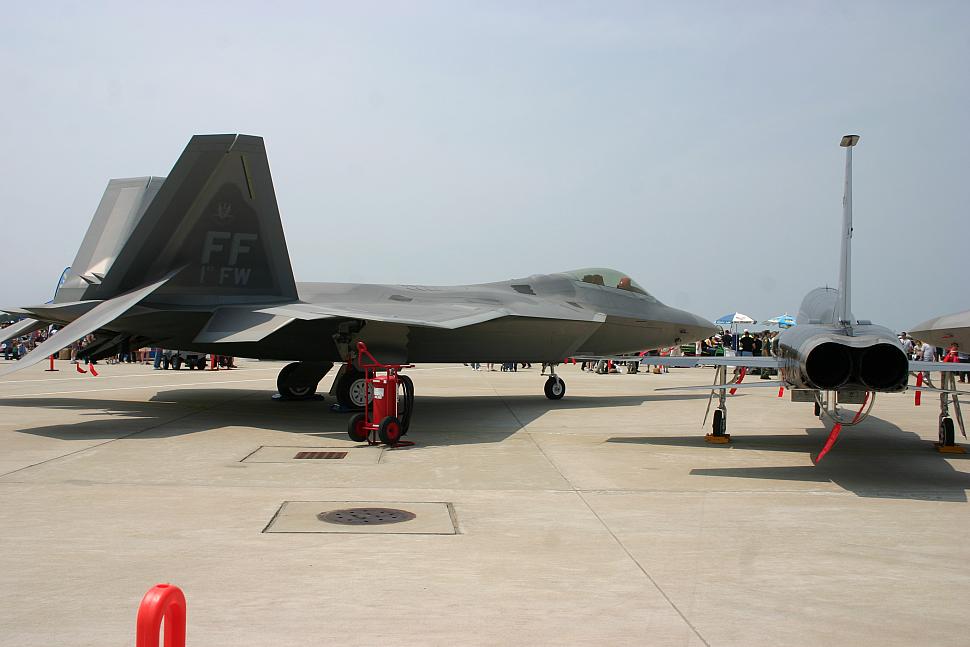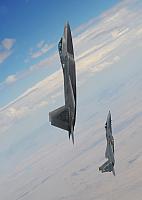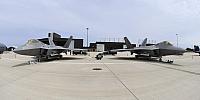Fighter Jet News
F-22 Raptor News
Air Force returns 170 grounded F-22s to service
September 22, 2011 (by
Lieven Dewitte) -
The U.S. Air Force ended the stand-down of all 170 jets after 12 incidents of pilots' experiencing hypoxia. With a mystery still swirling around why some pilots became light-headed while flying F-22 Raptors, the jets returned to the skies Wednesday nearly five months after the nation's fleet was grounded.

The fleet was put on stand-down in May over concerns about the system that delivered oxygen to pilots aboard the jets. That order came after 12 pilots reported hypoxia-like symptoms since 2008. Hypoxia is when the body does not receive enough oxygen.
The U.S. Air Force is now apparently satisfied that its F-22 Raptor stealth aircraft are safe to fly.
The USAF announcement did not explain whether the system has been changed but the plan includes these risk mitigation actions: rigorous inspections, training on life support systems, and continued data collection. "We now have enough insight from recent studies and investigations that a return to flight is prudent and appropriate," USAF Chief of Staff Gen. Norman Schwartz said. "We're managing the risks with our air crews, and we're continuing to study the F-22's oxygen systems and collect data to improve its performance."
The news release said an Air Force Scientific Advisory Board's report on the oxygen system will be released later this year. The return-to-fly plan "balances safety and the expedient qualification of pilots against the inherent risks of flying advanced combat aircraft," it states, adding that the entire F-22 fleet "will undergo an extensive inspection of the life support systems before returning to flight, with follow-on daily inspections."
The aircraft, which were introduced in 2005, are authorized to fly above 50,000 feet. Their pilots will use additional protective equipment and undergo baseline physiological tests, and the return-to-fly process will begin with instructor pilots and flight leads regaining their necessary proficiency, then follow with other F-22 wingmen.
They pilots also learned to recognize hypoxia-like symptoms that pilots sometimes experience at high altitudes.
"The symptoms you get are important to recognize, especially when you are in a single seat," said Col. Robert Garland, commandant of the Air Force Weapons School at Nellis. "Your fingers, your extremities get tingly and you experience a sense of euphoria, and your nose gets a little blue. Your body is being denied the oxygen it requires."
The F-22 Raptor was introduced in 2005, and it has flown more than 300 missions in support of Operation Noble Eagle and deployed on a rotational basis to the Pacific region and Southwest Asia.
The fleet is stationed at six bases: Joint BAse Elmendorf-Richardson, Ak.; Joint Base Pearl Harbor-Hickam, Hawaii; Joint Base Langley-Eustis, Va.; Nellis Air Force Base, Nev.; Holloman Air Force Base, N.M.; and Tyndall Air Force Base, Fla.
USAF F-22 block 35 #08-4162 seen at the Langley 2011 airshow on May 14th, 2011. [Photo by Landon S. Abbott]
The U.S. Air Force is now apparently satisfied that its F-22 Raptor stealth aircraft are safe to fly.
The USAF announcement did not explain whether the system has been changed but the plan includes these risk mitigation actions: rigorous inspections, training on life support systems, and continued data collection. "We now have enough insight from recent studies and investigations that a return to flight is prudent and appropriate," USAF Chief of Staff Gen. Norman Schwartz said. "We're managing the risks with our air crews, and we're continuing to study the F-22's oxygen systems and collect data to improve its performance."
The news release said an Air Force Scientific Advisory Board's report on the oxygen system will be released later this year. The return-to-fly plan "balances safety and the expedient qualification of pilots against the inherent risks of flying advanced combat aircraft," it states, adding that the entire F-22 fleet "will undergo an extensive inspection of the life support systems before returning to flight, with follow-on daily inspections."
The aircraft, which were introduced in 2005, are authorized to fly above 50,000 feet. Their pilots will use additional protective equipment and undergo baseline physiological tests, and the return-to-fly process will begin with instructor pilots and flight leads regaining their necessary proficiency, then follow with other F-22 wingmen.
They pilots also learned to recognize hypoxia-like symptoms that pilots sometimes experience at high altitudes.
"The symptoms you get are important to recognize, especially when you are in a single seat," said Col. Robert Garland, commandant of the Air Force Weapons School at Nellis. "Your fingers, your extremities get tingly and you experience a sense of euphoria, and your nose gets a little blue. Your body is being denied the oxygen it requires."
The F-22 Raptor was introduced in 2005, and it has flown more than 300 missions in support of Operation Noble Eagle and deployed on a rotational basis to the Pacific region and Southwest Asia.
The fleet is stationed at six bases: Joint BAse Elmendorf-Richardson, Ak.; Joint Base Pearl Harbor-Hickam, Hawaii; Joint Base Langley-Eustis, Va.; Nellis Air Force Base, Nev.; Holloman Air Force Base, N.M.; and Tyndall Air Force Base, Fla.
Related articles:
Forum discussion:
Tags
- F-22 pilots losing qualification as Raptors remain grounded ( 2011-08-05)
- Air Force grounds F-22 Raptors ( 2011-05-06)
- F-16 News: Carcinogen grounds Israeli F-16I jets ( 2008-03-21)
- F-22 Raptor news archive
Forum discussion:
- And they're back-- F-22 Fleet returns to flight ( 27 replies)
Tags
Additional images:

USAF F-22A block 10 no. 99-4011 and an F-15C Eagle from the USAF School's 433rd WPS pull into a vertical climb over the Nevada Test and Training Range on July 16th, 2010. [USAF photo by MSgt. Kevin J. Gruenwald]

USAF F-22 block 40s no. 08-4155 from the 27th FS & 08-4158 from the 94th FS, assigned to the ACC F-22 Demonstration Team at Langley AFB, stand by on the ramp of the 128th ARW, Gen. Mitchell International Airport, Milwaukee on June 10th, 2010. The Raptors are participating in the 2010 Milwaukee Air and Water Show. [USAF photo by SSgt. Jeremy Wilson]
